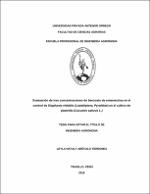| dc.contributor.advisor | Cabrera la Rosa, Juan Carlos | |
| dc.contributor.author | Arevalo Terrones, Leyla Nataly | |
| dc.creator | Arevalo Terrones, Leyla Nataly | |
| dc.date.accessioned | 2017-09-28T21:48:03Z | |
| dc.date.available | 2017-09-28T21:48:03Z | |
| dc.date.issued | 2017 | |
| dc.identifier.uri | https://hdl.handle.net/20.500.12759/3067 | |
| dc.description.abstract | Los campos de cucurbitáceas dañados por Diaphania nitidalis son muy
comunes en la zona, esta plaga se considera altamente perjudicial para el
cultivo debido a que este insecto barrena los frutos y éstos pierden su
calidad comercial. El mayor problema para combatir esta plaga está en el
desconocimiento del uso de las concentraciones necesarias para el control
químico.
Una de las moléculas más prometedoras para el control de este insecto es el
benzoato de emamectina, pero se desconocen las concentraciones reales
bajo nuestras condiciones, razón por la cual se realizó esta investigación.
El trabajo se llevó a cabo en el campus UPAO II. provincia de Trujillo,
departamento de La Libertad, con el objetivo de evaluar el efecto de tres
diferentes dosis de benzoato de emamectina para controlar Diaphania
nitidalis en el cultivo de pepinillo. Se utilizó el diseño de Bloques Completos
al Azar (DBCA) con 3 tratamientos y 4 repeticiones con un total de 12
parcelas en un área de 300 m². Los parámetros de evaluación fueron:
número de frutos dañados y proporción de frutos sanos/ frutos dañados.
Se demostró que hay un rango de efectividad mayor cuando la
concentración de insecticida es más elevada. Así se obtuvo la menor
cantidad de frutos picados con el tratamiento T3 (2%) y la mayor cantidad
en las parcelas aplicadas con la concentración más baja, 0.5% de benzoato
de emamectina. | es_PE |
| dc.description.abstract | The cucurbits fields damaged by Diaphania nitidalis are very common in the
area, this pest is considered highly detrimental to the crop due to this insect
bore the fruits and these loose their commercial quality. The biggest problem
to control this pest is in the lack of knowledge of the use of the
concentrations necessary for chemical control.
One of the most promising molecules is the emamectina benzoate, but it is
not known what the real concentrations should be used under our conditions
and for this reason why this investigation was conducted.
The work was performed in the Campus UPAO II. Province of Trujillo, La
Libertad department, in order to assess the effect of three different doses of
emamectin benzoate for control of Diaphania nitidalis in cucumber crop. It
was used randomized a complete block design (RCBD) with 3 treatments
and 4 replicates with a total of 12 plots and an area of 300 m². The
parameters of evaluation were: number of damaged fruits and proportion of
healthy fruit and damaged fruit. It was showed that there is a range of more
effectiveness when the concentration of insecticide is higher. It was obtained
the least amount of bored fruits in the treatment T3 (2%) and the most the
plots applied with the lowest concentration, 0.5% emamectin benzoate. | en_US |
| dc.description.uri | Tesis | es_PE |
| dc.format | application/pdf | es_PE |
| dc.language.iso | spa | es_PE |
| dc.publisher | Universidad Privada Antenor Orrego - UPAO | es_PE |
| dc.relation.ispartofseries | T_ING.AGRON_468 | |
| dc.rights | info:eu-repo/semantics/openAccess | es_PE |
| dc.source | Universidad Privada Antenor Orrego - UPAO | es_PE |
| dc.source | Repositorio Institucional - UPAO | es_PE |
| dc.subject | Cultivo de pepinillo | es_PE |
| dc.subject | Diaphania nitidalis | es_PE |
| dc.title | Evolución de tres concentraciones de benzoato de emamectina en el control de Diaphania nitidalis (Lepidoptera, Pyralidae) en el cultivo de pepinillo (Cucumis sativus L.) | es_PE |
| dc.type | info:eu-repo/semantics/bachelorThesis | es_PE |
| thesis.degree.level | Título Profesional | es_PE |
| thesis.degree.grantor | Universidad Privada Antenor Orrego. Facultad de Ciencias Agrarias | es_PE |
| thesis.degree.name | Ingeniero Agrónomo | es_PE |
| thesis.degree.discipline | Ingeniería Agrónoma | es_PE |

